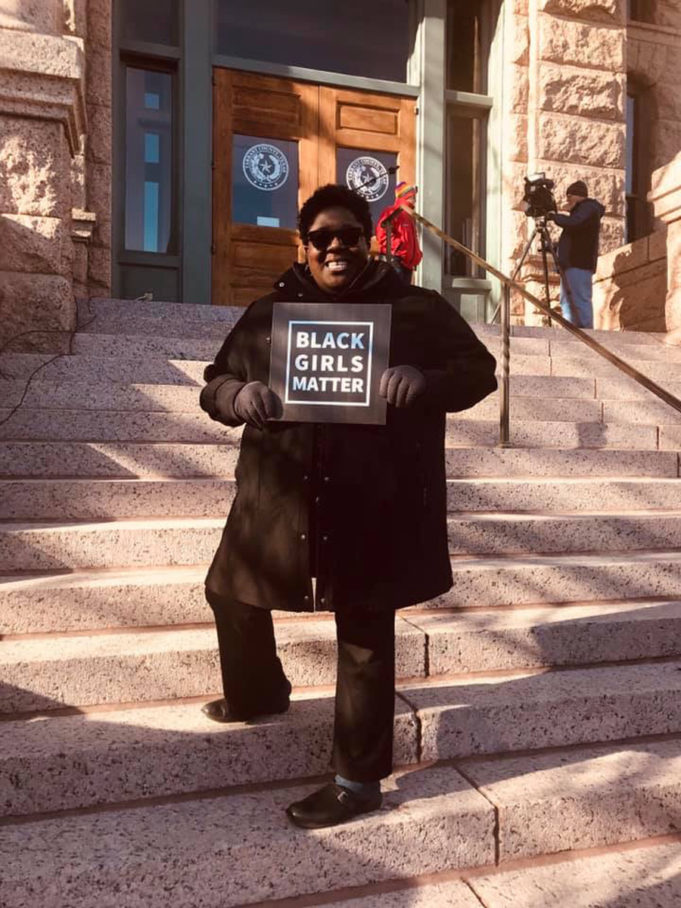The return to school has morphed into a season of unrest unto itself. The “COVID question” is still very much unanswered, but one group has worked and protested to make their voices heard, and it’s a cohort of women urging our cities’ officials to open schools in person as soon as possible. Their professed reasons are legitimate. Underprivileged and at-risk youth especially need to be in school for social support. It’s where they receive the education that will allow them to lift themselves from poverty. Schools may provide the only decent meal those students will eat every day. Their home situations might even be neglectful or downright dangerous. These calls to “save the children” didn’t seem to be coming from the group whose children would be directly affected. Instead, the carefully painted and glittered protest signs were being held aloft by overwhelmingly white and privileged members of Fort Worth’s Tanglewood neighborhood. It seems that the influence of these protesters calling for schools to open on normal schedule may have been successful, as Fort Worth schools amended their original in-person start date of September 28 to right after Labor Day.
School district trustee Ashley Paz said the school board has not caved to the demands of any faction. She said the school board will vote on the resumption of in-person learning on September 15, and extending online classes past September 28 remains an option.
Another group, the female students of the Fort Worth school district — particularly the Black ones — brace for a business-as-usual semester in which they will inevitably fall last on the school district’s priorities list. The school district suspends Black girls at a disproportionate rate, according to a 2018 academic article written by Dr. Altheria Caldera, an educational doctorate graduate of TCU. If statistically inclined, it’s noteworthy that Fort Worth school district was suspending all students more often than any other major urban district in the state save for Houston. Black girls made up 12% of Fort Worth’s student population but represented 62% of female suspensions and 18% of total suspensions. I don’t seem to recall any protests at the time, but we also didn’t seem as protest-y back then.
Sitting in an empty classroom at Denton’s Ryan High School, where I teach world history and coach tennis, preparing assignments on tandem desktop computer screens, my laptop dinged with the arrival of the interviewee to my virtual Zoom table. A sans serif “A” disappeared to reveal a smiling Dr. Caldera broadcasting from her home office in Fort Worth. The former assistant professor from Texas A&M University-Commerce greeted me warmly as we discussed events of this summer before she apologized for her husband’s hand delicately placing a veggie burger on her desk.
“Hand sanitizer, please,” she requested before returning her attention to me.
“So do you think the protests were beneficial for Black women?” I said.
“Breonna Taylor was killed before George Floyd, but it took his death for the national attention to start,” she responded.
*****
This year has brought stark changes to everyone’s lives as efficiently as an Amazon Prime delivery. Among these are a grab bag of cliches that are likely invading your vernacular regardless of age, race, gender, or occupation: “new normal,” “flexibility,” “fluidity,” “uncertain times.” Amid divided pressures, school districts across North Texas are opening their doors and web portals to welcome back students. Fort Worth’s is currently in preparation mode before butts hit the plastic. This opening timeframe is one of several that have been proposed and reconfigured as health officials and Texas’ seesaw politicians try to decide who’ll be holding the proverbial hot potato last and who inevitably will receive the blame if this entire pand-experiment goes awry.
Discipline problems in a virtual classroom are likely the last thing on the minds of most parents or administrators as they embark on the logistical nightmare of connected learning. But absurdities can still happen. School districts are already girding their expectations that students should be dressed as they would be in school when attending virtual class — the consequences for pajama conferencing haven’t been made clear.
One student in San Antonio has already garnered media attention by pulling up his shirt and making sexually charged comments toward his art teacher during a class video conference. The first week in the nearby Lewisville school district revealed different problems as bandwidths maxed out almost immediately as teachers across the district tried to live conference with thousands of students simultaneously. Maybe we’ll just ask the students to send in pictures of themselves in proper learning attire. No way that could go wrong, right? Outrageous stories aside, discipline referrals from virtual learning seem unlikely, because what would be the point?
Despite primary education’s current digital form, it’s important to consider the concept of out-of-school suspensions in general. Credible research documenting the educational and career outcomes of students suspended during their primary education is unsurprisingly poor. Soberingly, those who are suspended in grades 7-12 are at a significantly greater risk of being victimized by criminals, engaging in criminal activity themselves, or eventually becoming incarcerated. It’s also a foregone conclusion that most students — especially Black and brown ones at the bottom of the socioeconomic scale — will sit masked in cramped classrooms by early October at the latest, so the issue will regain relevance sooner rather than later.
In Fort Worth specifically, a brief media backlash followed Caldera’s statistics coupled with two print articles and a feature criticizing the district’s practices on the radio program Texas Standard. Dr. Kent Scribner, Fort Worth superintendent, had already introduced a new Racial and Ethnic Equity Policy the previous year. In her study, Caldera commended the district for good-faith actions toward reconciling what has been a longstanding racial equity problem within the district, with the caveat that failing to recognize gender as an important component left the initiative unfocused from the beginning.
Racialized sexism, as Caldera categorizes it, is not a problem du jour. The White House collected figures in 2015 and reported the suspension rate for Black girls is 12% higher than girls of any other race. Southern states are the worst offenders, with female Black students representing 56% of all suspended girls. Texas, specifically, logged greater percentages in every grade level than either white or Hispanic girls. My friendly interviewee never accused Fort Worth schools of ignoring girls of color with the new initiatives. Rather, she said, schools are failing to recognize the unique nature of being Black and a woman which must be addressed as a standalone initiative. Simply addressing race or gender separately misses a mark they may have never considered an essential target in the first place.
Most groups and individuals can accurately be accused of transient activism. We’ve just experienced arguably the most racially charged summer of the century. It also seems that in the wake of furloughs, layoffs, and working from home as a result of the COVID-19 pandemic, Americans have suddenly remembered their First Amendment rights of assembly. Protests of all sizes and types, centered on everything from Floyd’s death, a rogue hair salon owner defying public health orders to close in Dallas, or the removal of Confederate monuments around our metro area, have swelled and quieted for months. The common theme I’ve noted from groups who are and have been suffering is a resounding “thank you,” with the qualifier that these problems have been around and will continue to be around without a sustained collaborative effort from everyone. Systemic change doesn’t happen quickly and, in most cases, can’t be legislated into existence. Least effective of all are empty-rhetoric mission statements and fanciful language or even blacked-out Instagram posts.
*****
Caldera doesn’t fault the Fort Worth school district for recognizing that they have poorly served their Black student population but does assert that simply adopting the equity of races is far too general to ultimately be effective by the most vulnerable population served: Black girls. Both race and gender have long plagued American equity in an essential rights and functional capacity. The 19th amendment, guaranteeing women the right to vote, celebrated its 100th anniversary just a week ago when it passed the threshold of 36 states as Tennessee adopted the law into Constitutional finality. This represents in a plain sense what Caldera argues is a necessity when attempting to reconcile achievement gaps for Black girls within the American education system: They’re usually going to wait twice as long for everything. Caldera’s study, Suspendable and Expendable, Kicking Out and Throwing Away Black Girls: An Analysis of a School District’s Policies and Practices, summarizes why it is important to understand the underlying context for why girls of color are viewed differently from their counterparts and how the designation of gender in analyzing their outcomes is essential. It could nary be argued, at least not effectively, that white men established our country and its institutions at large. The rules, standards, and practices of these institutions are unsurprisingly constructed to be navigable by the same population by which they were established. White women have and continue to fight institutional patriarchy through many trajectories through feminist movements that have been fought over multiple centuries for equivalencies such as compensation for equal work and voting rights. White women, for all the struggles they face at the hands of patriarchy, are still ingrained and hold a place in the system they’re trying to bend toward their own equality. Caldera prefaces her study with scholarly reminders that Black women face an intersectionality of both sexism and racism that can’t be considered as parallels but are forever linked.
How are black girls viewed differently?
Equity is an elusive concept. The simplistic answer is to treat everyone the same and everything will work out fine. Statistics argue this logic is flawed, and natural bias proves time and again that humans are widely incapable of treating everyone the same regardless of sexual and racial designations. Black girls, as referenced by nationwide surveys and studies of educators, are viewed as outspoken and challenging and loud, and they dress provocatively. The aforementioned characteristics are likely influenced by the longstanding stereotypes of the angry Black woman or the sexualized Jezebel. These biases lead to acute adultification of Black girls when compared with their white counterparts, who are more likely to be perceived as delicate and in need of protection. I asked about what I believed to be a common archetype for Black women as strong and long suffering.
Caldera confirmed my perception and responded, “I refute the strong-Black-woman stereotype. My question is at what cost? No, I have vulnerabilities and weaknesses. White women are thought to be more fragile or needing protection and care. Black women can take it, we can endure, and we got it. It’s a dangerous characterization which plays into the adultification of Black girls, so they aren’t seen as needing protection in the way that they should be.”
A report from the African American Policy Forum and Columbia Law School’s center for Intersectionality and Social Policy Studies found that Black female students are more likely to be suspended multiple times than any other gender or race of students and also receive harsher punishments for the same infractions. If these statistics seem familiar, they mirror our country’s criminal justice inequities regarding race in our court systems that have been at the forefront of various movements to defund the police and reform criminal justice practices that are perceived as unfair to Black and brown populations. In 2017, a Black woman was nearly twice as likely to be incarcerated as a white woman and nearly 50% more likely than a Hispanic woman.
*****
“You look rich as shit, sir,” said the performer to me at Hyena’s comedy club some years ago as he worked the crowd during his set. “Are you rich as shit?”
I was surprised by his attention as I sat drink in hand with my then girlfriend enjoying an evening downtown.
“Definitely not,” I chuckled in response. “I’m a teacher in South Oak Cliff.”
The Black comedian was obviously surprised by my answer. “Man, I’m surprised those kids haven’t eaten you alive! Especially those girls. Even I can’t get them to act right.”
The audience laughed, as did I, but I’ll blame it on the two-drink minimum. Realistically, I didn’t agree. I was in the middle of coaching my powerlifting season, and my girls team — entirely Black — featured my best performers and hardest workers. But the notion from the comedian was familiar and had been shared by former colleagues: “Black girls can be hard to teach.” It wasn’t something I had experienced personally but had been told to watch out for the warnings. Kids are kids, I’d always thought. They’re all going to have tough days. But the distinction wasn’t lost on me, and it still isn’t.
“We are the sacrifice,” Caldera said with friendly composure tinted with emotional exhaustion. “Black women are always at the forefront of social justice movements.”
“Are things improving in FWISD?” I asked with general concern, assuming the attention of years past had at least created marginal forward momentum in addressing this problem specifically.
“No one will be able to tell you that because no one is collecting the data,” she said. “Either it’s not being collected or its not being distributed.”
Caldera had checked in with administrators within the district earlier this year but wasn’t provided a clear answer. She used her social media to pose the question to a broader audience, including school board members whom she had come to know through her research process. Sherry Breed, Fort Worth schools’ chief of Equity and Excellence, reached out to provide updated suspension numbers. Those numbers encapsulated the continued disconnect within the district: aggregation. Suspension numbers are categorized by race and offense but not gender. In many cases, the reason is missing as well. The pitfalls in data collection are something our researcher had encountered before, having to ask for a manual breakdown of these statistics to complete her research. This process — after special request — was completed by the district but only after charging Caldera $60 for the labor of the breakdown, 60 bucks that had to be paid in cash and delivered in person at the district office.
“Why are these students being suspended?” I asked, knowing myself as a teacher that there is tremendous discretion when referring a student to administration to even be considered for suspension-type punishment.
Caldera, exasperated, said, “They don’t have a way to identify the reason girls are being suspended. One broad category, one nebulous code that has no meaning. We have to speculate because the district can’t tell you.”
The code to which she’s referring is Code 21 — Student Code of Conduct. According to her communications with Assistant Superintendent Michael Steinert, Code 21 is a broad category of infractions lacking specificity in the PEIMS (Public Education Information Management System) codes that detail infractions that lead to suspension. A computer breakdown will reveal only how many students and of which race were suspended and the infraction based on the PEIMS code. Gender is not a component that can currently be disaggregated for reporting, including the most current data. Steinert told Caldera that two years ago the district needed more robust software to track these offenses as well as better training for the administrators logging them. Without those things, which have yet to be publicized, students are thrown into the Code 21 matrix of mystery, and we just know what they did must have been bad enough to warrant a suspension, even if it was talking back to a teacher who was having a bad day or for multiple dress code infractions.
It’s hard to imagine that the reporting and disaggregation of discipline data ranks high on Fort Worth schools’ list of action items amid the complications brought by COVID-19 reopenings. This shouldn’t mean they’re off the hook. When the children of Tanglewood return to school, it’d be nifty if the parents can retrieve some of their protest energy to move on this issue as well.












